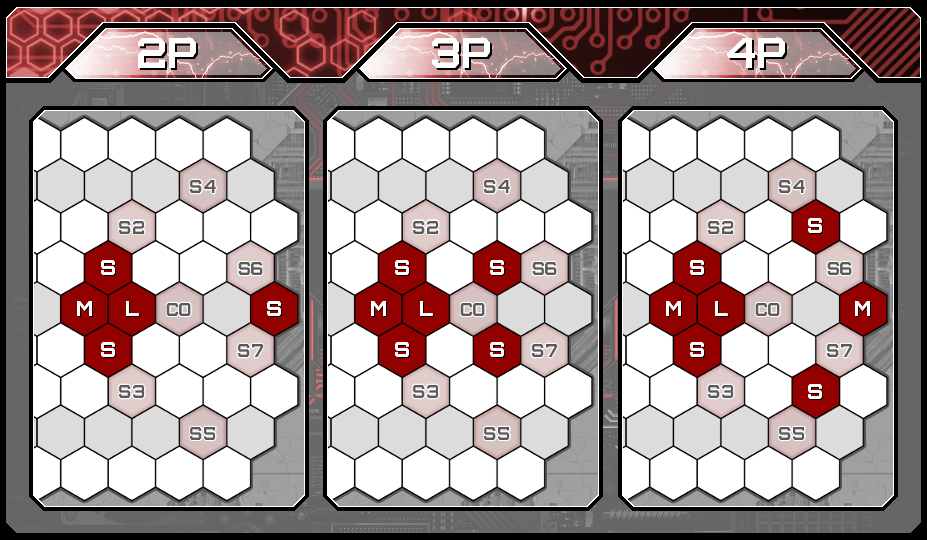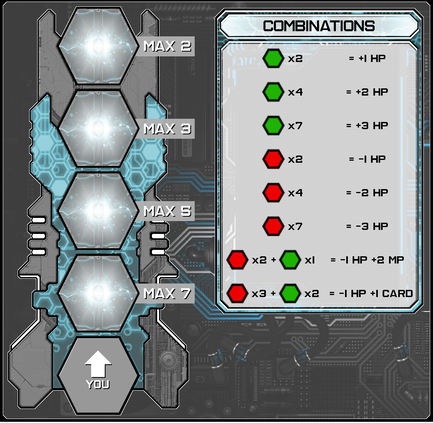|
Major Changes NEW MECH: ALCHEMIST While Scavenger can apply some minor healing, Crash Command has lacked a dedicated healer mech. Filling in this gap is Alchemist, a new Strider support mech. Alchemist leverages her Arkite Fusor beam, allowing her to both damage and heal at the same time depending on the configuration of the Fusor beam. To do this, Alchemist has a unique system that allows for the combination of Red and Green Arkite Prima. Passive: Arkite Prima Arkite Prima come in either Green or Red form and can be stacked in in the Arkite Fusor. Once per Player Phase, as an action, you may fire your Arkite Fusor, affecting targets on your front axis based on its current configuration. Then remove Prima from each space equal to the amount of HP lost or gained by that space. Alchemist looks to capitalize on the following key traits: As a Strider, she should have an innate focus towards team support and positioning. As a healer, she should have a strong healing ability, while still being able to support outside of healing. As a more of an entry-level support mech, her core mechanics should be easier to understand and leverage. Minor Changes: Roquer Entraver Decreased the wallbump damage to 1, and now all targets (not just Invaders) can be affected by it. Fixed minor text issues. Corsair Parley’s Utility bonus now also increases the number of cards drawn from 1 to 2. Booby Trap now helps reduce damage taken, but no longer siphons Arkite from that particular silo. Blacksmith Changed several Instant DUO bonuses to Defense-based rather than Utility-based.
0 Comments
 Major Changes INITIAL DEPLOYMENT REWORK The Initial Deployment (referenced on the back of the Army Extra Info Placard) has been relatively untouched since the beginning of the game. Until now. In an effort to reduce complexity, the initial wave of reinforcements for each army stays the same, regardless of the number of players. This one-size-fits-all approach does have some obvious downsides, namely being too hard for 2-player games, while being too easy for 4-player games. 2 years later, there’s been enough data from 2 and 4 player games to show that this just simply does not work, and cannot work, even with all of the other scaling elements in the game. So, the Initial Deployment chart has split into three. The new version of the Initial Deployment chart now has three layouts, one for each different set of players. The variants for each set of players can be relatively small for some armies, or quite impactful for other armies! ARK ANGELS REWORK As the “big bad” faction of Crash Command, Ark Angels needs to pull upon all possible strategies the players have used thus far, as well as “cheat” a little to give them that classic SNK boss feel. In previous iterations Ark Angels has swung wildly from too strong to too weak due to having so many moving parts to properly function. And so, once again, a rework as been applied since the last playtest. Ark Angels still focus on utilizing Arkite, more so than the players or the Terminus. To facilitate this, two major changes have been applied. Grim Matrices now will prioritize giving Arkite to cards without Arkite. In addition, any Arkite used up by Commander cards now go directly into their stockpile. This could create a more evenly boosted effect across all of the Commander’s cards, making juggling the CO’s attention more critical than before. Reinforcement Cards now act as PSD-style upgrades to existing Commander cards. This is best characterized by the new entry level card, “Blue Sophia”. "Place this card underneath a Commander card. Increase the maximum and current HP of that card by 3. Whenever the Commander card above is destroyed, this card is played again." Because of this card and other cards, the Commander’s Function should power up similarly to the Players’ as the game goes on, making it feel more like the dramatic duel that the army has been building up to. Minor Changes Templar King’s Ground PSD cost increased from 3 to 4. Panzermarine Minor card text issues and wording fixed. ATLAS REWORK
Atlas has always been in an odd spot due to his role and his mech class. Being a grappler mech, he has the some of the highest potential for enemy disruption in the game, only mirrored by Siren. This also makes him a difficult mech to play, as taking advantage of positioning is always going to be more difficult than dealing damage. Atlas’ previous passive, Showmanship, attempted to give him a duality of purpose; you could either move things around, or bop them into one another for some damage, wrestler-style. But repeated playtests showed that players heavily leaned towards simply moving targets into other targets for damage, leaving the board pretty undisturbed. In addition, this caused Atlas to have a 1:1 card-to-damage output that was usually reserved for Marauders, in addition to him having his extended health pool. The new Atlas looks to emphasize target movement more than damage, while still allowing him to deal some damage. This required a complete overhaul of his core mechanics, first by changing the old passive Showmanship to Magnetic Battler: Magnetic Battler Whenever your card effect would cause a target to move into another target, you may first shift the blocking target 1 space out of the way to allow movement to happen. You may then spend 1 MP to deal 1 damage to one of the two targets. To compensate for this, Atlas' MP has been bumped up to the normal 3, and several cards can help him generate more MP, giving him a "burst mobility" option similar to Scavenger, something that he can trade off for damage instead. These changes look to improve upon Atlas’ key traits:
VOLCANO REWORK By now, Volcano is now one of the older mechs in the game, and his kit shows it. His average output has both been consistently easy and high, with him being the only mech that can possibly deal 4 damage consistently from Turn 1. This was supposedly counterbalanced by his poor mobility, inability to hit targets up close, and his need to finangle with his Blast Chart to reach optimal damage conditions. As a wise man once said, “the best form of crowd control is death”. And with a mech that pumps at at least 4 damage per turn, that was especially true. A lot of Volcano’s inherent weaknesses and his slow ramp-up time was offset by his ability to outpace Invader Reinforcements. His Blast Chart mechanic was both simultaneously difficult to understand, but easy to optimize, allowing him to keep his damage high. The new Volcano looks to preserve his role of a long-range siege mech that focuses on splash damage, recalculated for how the game now escalates due to the Arkite System. The Blast Chart and its wording also received changes to better emphasize his role. The Spotter system was also removed for simplicity, and now simply references other Player mechs on the board as “spotters”. Siege Shelling At the start of the game, add Blast tokens #1 and #2 to their spaces on the Blast Chart. The Initial Zone is the point of reference for the Blast Chart when Shelling. Each Blast token deals 1 damage to its respective space during Shelling. Blast tokens may stack. At the start of each Player Phase, all Blast tokens jump back to their own corresponding spaces. Accompanying the changes to his Passive, his Blast Chart has now been changed as well. Previously, markers on his chart would persist between phases. Now, markers are individually identified, and jump back to their respective spots. This means that players need to actively shift around tokens to optimize their damage per turn, while minimizing friendly fire. This also means that buying new tokens is less straightforward; with each token having their own unique position and cost, players will need to consider the opportunity cost of moving those tokens into useful position. These changes look to improve upon Volcano’s key traits:
MINOR CHANGES Centurion - Centurion Resolve Effect changed to: "Until the start of the next Player Phase, reduce damage taken from all attacks by 4." This allows the card to be a stronger version of Anticipate, while playing off of his damage-reduction theme and bonuses. This also prevents weirdness from multi-hitting attacks, HP-decrease effects, and other strange interactions that might stem from the "inability to lose HP", rather than reducing damage taken. Thanks for stopping by!
Welcome to CRASH COMMAND, a one- to four-player cooperative board game chock full of strategic choices, custom combos, and giant mechs. Inspired by old-school strategy games like StarCraft and Advance Wars, I’ve been working to package the strategic depth of games like them into a tabletop, cooperative experience. At this point in time, CRASH COMMAND has been in development for almost two years. Only relatively recently has game started to settle down into a more stable state, with core game mechanics meshing together better than ever before. Of course, this would not have been possible without the monumental time spent by you, the playtesters! Thanks to all of you have who have been playtesting the game from its inception, whether it be at conventions, or at our weekly playtest sessions! |
Archives
May 2019
Categories |
